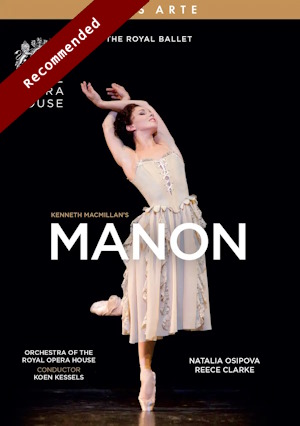Kenneth MacMillan’s Manon
Ballet in three Acts (1974)
Music by Jules Massenet (1842-1912), compiled by Leighton Lucas with the collaboration of Hilda Gaunt
Orchestrated by Martin Yates
Choreography by Kenneth MacMillan
Manon – Natalia Osipova
Chevalier des Grieux – Reece Clarke
Artists of the Royal Ballet
Orchestra of the Royal Opera House/Koen Kessels
rec. 2024, Royal Opera House, Covent Garden, London
Opus Arte OA1390D DVD [131]
Kenneth MacMillan’s full-length ballet Manon was premiered at the Royal Opera House, Covent Garden, on 7 March 1974. The theatre audience gave the production an ecstatic response and, even if the choreographer himself later liked to deny it, the critics too were generally positive in their verdicts.
What negativity there was tended to come from opposing extremes of the spectrum. Some originated from a mixture of reactionary Mary Whitehouse-style morality and a lofty distaste for the so-called “permissive society”. Thus, The Guardian’s Mary Clarke opined that the leading female character was “a slut”, her lover was “a fool” and the rest of the characters nothing but “the most unsavoury company” (quoted in Jann Parry Different drummer: the life of Kenneth Macmillan [London, 2009], p. 437). Another line of criticism derived, on the contrary, from 1970s progressive sexual politics and Women’s Lib ideology, most famously when Jane King, writing in the communist daily Morning Star, railed against the way in which, she claimed, MacMillan had depicted the central character as “a nasty little diamond digger” and argued that “You do not have to be a militant feminist to resent… [the] repeated representation of the female sex as deceiver and destroyer of the male” (ibid.).
To most of us today, such lines of criticism seem rather bizarre, if not ridiculous. Indeed, 21st century commentators are virtually unanimous in considering Manon to be one of MacMillan’s greatest achievements and one of the Royal Ballet’s crown jewels. When we find the critic employed by today’s Daily Express – a newspaper that’s usually antipathetic to anything smacking of liberal “wokery” – describing its tale of thieves, pimps, panders, whores, libidinous aristocrats and decrepit sugar daddies, all perpetually on the hunt for either money or sex, as “a beloved masterpiece”, we can be pretty certain that Manon’s place in the modern ballet repertory is secure.
This year has seen the work’s 50th anniversary and Covent Garden hasn’t let the opportunity to mark the occasion pass. No less than 14 performances were staged between 17 January and 8 March, with the leading roles shared between many of the Royal Ballet’s top stars as well as some of the company’s up-and-coming dancers. Forced to choose among such an embarrass de richesses, I attended the 17 February performance headlined by Marianela Núñez and Roberto Bolle. As far as I could see, there were no professional cameras in the auditorium to record the show, a decision possibly determined by commercial considerations as Bolle’s interpretation of the leading male role has already been memorialised on DVD (see below). Nevertheless, as you’d expect from the Royal Ballet which, virtually alone among the world’s top dance companies, still takes the trouble to film and release most of its productions, at least one of those 14 Manon performances was filmed and is now available for consideration in this review.
Rather usefully for our present purposes, back in February when I was preparing for my trip to Covent Garden, I watched all the filmed versions of the ballet that I could find. In chronological order of performance, they included those featuring Jennifer Penney/Anthony Dowell/The Royal Ballet/1982 (Warner Music Vision DVD 8573-84201-2 – review), Justine Summers/Steven Heathcote/The Australian Ballet/1995 (Faveo/Opus Arte DVD OA F4006 D), Tamara Rojo/Carlos Acosta/The Royal Ballet/2008 (Decca DVD 0743346 – review), Aurélie Dupont/Roberto Bolle/Ballet de l’Opéra National de Paris/2015 (BelAir Classiques Blu-ray BAC435) and Sarah Lamb/Vadim Muntagirov/The Royal Ballet/2018 (Opus Arte Blu-ray OA BD7255D – review).
I reviewed the last of those five years ago. As the filmed record of a Royal Ballet production that has remained essentially unchanged since then, it shares, as you would expect, many of its characteristics with the new release now under consideration. We see a few of the dancers, including Gary Avis as the villainous Monsieur G.M., reprising their roles in both, while the two productions also share the same highly experienced conductor, Koen Kessels. I will not take up valuable space here by repeating many of the general points that I made about the 2018 performance, the ballet’s score and the varied ways in which dancers approach its complex, morally conflicted leading roles. Instead, I suggest that, if interested, you take a moment or two to look back at that previous review.
Even if many elements of the 2018 and 2024 performances remain much the same, watching the newer one reminded me of a couple of the Covent Garden production’s central features that are, I think, worthy of a little more detailed examination than I previously gave them.
The first is the important contribution made by designer Nicholas Georgiadis. The original novel on which Manon is based, the Abbé Prévost’s Histoire du Chevalier des Grieux, et de Manon Lescaut, had been set in the early 18th century. However, Georgiadis suggested that the stage action take place in the later 18th century, thereby offering the opportunity to emphasise even further the immense gulf between the wealthy and the destitute that had developed in pre-Revolutionary France. In particular, the time-shift allowed the era’s lavishly over-the-top fashions, all elaborate creations of satin, lace, frilly bows and gorgeous jewels, to be contrasted dramatically against the filthy, tattered clothes barely hanging off the backs of the downtrodden poor. Georgiadis sets that stark juxtaposition in front of an immense back wall draped with even more dirty rags and scraps of material, an effectively dramatic symbol of the rotten foundations on which the Ancien Régime rested. That “cloth cesspit”, is a really smart device, theatrically adaptable enough, as Jann Parry notes, to “look as velvety as fur or as rank as unwashed clothing” simply by making changes in the way it is lit (op. cit., p. 431).
The designer’s chosen colour palette, very 1960s and ‘70s in its striking in its deployment of bloody reds, sickly oranges and faecal browns, will, incidentally, appear rather familiar to anyone who’s seen the better-known MacMillan/Georgiadis/Royal Ballet collaboration Romeo and Juliet (1965).
A second aspect of the ballet that’s worth a little more examination is its musical score. At the time of Manon’s premiere Leighton Lucas and Hilda Gaunt’s arrangement of various pieces by Massenet – which, incidentally, completely excludes anything from the composer’s 1884 opera of the same name– had come in for some pointed criticism. Richard Buckle, for instance, while conceding that it “rises to its dramatic occasions”, still thought it essentially “a hotch-potch of bits and pieces, conventionally orchestrated” (Richard Buckle Buckle at the ballet: selected criticism by Richard Buckle [London, 1980], p. 174). Meanwhile, Mary Clarke observed somewhat sniffily that “By the end of the evening, you do get awfully tired of Massenet” (quoted in Parry op. cit., p. 436). Such negative reactions can still be encountered today. In February this year, for instance, my MusicWeb colleague Jim Pritchard watched a cinema relay from Covent Garden, after which he reported that the ballet’s “over lush” score was “a major weakness… it remains a strangely Classic FM-like musical potpourri”.
In the past couple of weeks, I have listened to the score a great many times, both while watching this new DVD and on CD (there is an absolutely first-class recording by the Orchestra of the Royal Opera House, Covent Garden under Richard Bonynge on Decca 470 525-2). Contrary to the verdict of those earlier critics and with all due respect to Jim, with whose review I otherwise concur on virtually every point, I find it absolutely fit for purpose and, indeed, a quite exemplary achievement. The score has it all. There are great soaring and sweeping romantic themes that are appropriately deployed at times of the greatest emotion (Act 1, Scene 2: the pas de deux set in des Grieux’s bedroom; Act 3, Scene 3: Manon’s death in the Louisiana swamps). There are also lively foot-tapping dances for the whores and their sugar-daddy customers in Madame’s hôtel particulier (Act 2, Scene 1). There is subtly supportive music for the scene-stealing comic dance between Manon’s drunken brother and his mistress (Act 2, Scene 1 – “one of the best numbers a British choreographer ever invented” [Buckle, op. cit., p. 175]). And there is plenty of other well-chosen music that serves the requirements of the on-stage action remarkably well, teasing out, emphasising and enhancing the full emotional impact of what we are witnessing on stage. Nowhere, to my own ears, does the score outstay its welcome in the slightest.
Of course, in the end Kenneth MacMillan’s choreography and the Massenet/Leighton/Gaunt score can only provide the opportunity for a great performance of the ballet. Ultimately, any performance’s success or failure rests primarily upon the dancers. In the ballets of the 19th century, it was merely enough for them to dance very well, but the more realistic style and subject-matter of 20th century ballets have increasingly required that performers should not simply ornament the stage in a pretty fashion but should also act.
This is where this newest performance of Manon on film certainly scores. While the Royal Ballet appears to have – unlike many other top companies – a commendably egalitarian and comradely ethos, most balletomanes would, I think, agree that Natalia Osipova is, along with Marianela Núñez, one of its very finest dancers. Her fine technique is, moreover, augmented by a spirit of physical adventurousness and risk-taking that particularly suits her to the highly dramatic roles into which she unrestrainedly – and often quite literally – throws herself (MacMillan’s Anastasia Act 3, Sidi Larbi Cherkaoui’s Medusa, Arthur Pita’s The mother). Ms Osipova left Russia in 2011 in search, as she said at the time, of “artistic freedom” and has subsequently taken advantage of Western audiences’ greater openness to experimentation. She has increasingly chosen highly dramatic roles that encourage her not only to deploy the physicality of her whole body but to exhibit greater subtlety in both gesture and facial expression. While Manon can certainly be portrayed one-dimensionally as little more than a “wanton with a heart of silver-gilt” (Buckle op. cit., p. 174), Osipova instead creates a believable, multi-faceted and, above all, human persona for the character. That degree of psychological complexity allows audiences wide latitude in interpreting Manon’s moral compass and divining her motivation and so makes the story much deeper and more thought-provoking. By the time that she offers up her physical and emotional all in a gut-wrenching account of Act 3, it is clear that we are watching Osipova give what is surely the most moving performance of the role yet recorded on film.
In that, she is very well supported by danseur noble Reece Clarke, whom she describes in an accompanying extra DVD feature as her favourite partner. His role of the lovelorn student des Grieux is not an easy one. While we like to think that our leading man will be to some degree heroic, des Grieux is, for most of the ballet, essentially a weak, immature boy. He follows Manon around like a lapdog even after she betrays him and is easily led into a life of criminality that begins with cheating at cards – at which, of course, he turns out to be absolutely useless – and ends with committing murder. Moreover, in choreographic terms, there are long stretches where des Grieux has little to do other than stand relatively passively on stage and watch others dominate the dramatic action. In the 2018 performance, such a milksop characterisation suited Vadim Muntagirov’s diffident persona rather well. In 2024, however, Reece Clark takes a different approach. Like Osipova, he ups the ante on the acting, so that ultimately we come away with the impression that des Grieux is the architect of his own destiny and, indeed, his own downfall. A fine technician, Clarke has been Osipova’s regular partner on stage for the past five years. Their shared experience and the consequent level of mutual trust that’s been engendered mean that they dance together at the highest level of execution.
Manon’s brother Lescaut is, in some ways, the pivotal character in the ballet. It is, after all, he who sets the whole sorry story in motion by pimping his sister to the libertine Monsieur G.M. and who precipitates her final downfall by wounding the latter in a fight. Kenneth MacMillan very much wanted the audience to appreciate the role’s importance, which is why, for a moment or two after the curtain rises on Act 1, we see Lescaut sitting alone on stage and looking directly out into the auditorium before the main action begins behind him. This year saw Alexander Campbell’s retirement from dancing as he left to take up the artistic directorship of the Royal Academy of Dance. Indeed, the role of Lescaut marked his final appearance with the Royal Ballet. While it inevitably faces comparison with the stand-out performance in the part given Ryoichi Hirano in 2018, Campbell actually delivers a somewhat different but equally compelling account. The Japanese dancer had chosen a quite legitimate path of emphasising Manon’s brother’s vile malevolence. Campbell, on the other hand, skilfully uses small elements of characterisation to suggest that Lescaut does, after all,ultimately care about his sister and thereby generates a degree of compassion for him. Having thus left the Royal Ballet company on a great high note, he will certainly be missed. [Incidentally, there is something of a tradition of dancers concluding their careers with Manon. The Paris Opera Ballet étoile Aurélie Dupont selected it for her 2015 farewell, while Roberto Bolle – who had actually partnered Dupont in that final outing – danced Manon in the last performance that he gave with American Ballet Theatre.]
Of the remainder of the major characters on stage, Gary Avis reprises his role as the perpetually sneering Monsieur G.M. so effectively that any audience member would surely storm the Bastille and send him straight to the guillotine without a moment’s hesitation. Mayara Magri, in the role of Lescaut’s put-upon mistress, is another dancer who faces stiff competition, for Itziar Mendizabal’s partnering of Ryoichi Hirano in the comic “drunken” dance was a real highlight of the 2018 performance. Ms Magri, however, more than holds her own. Let me give a mention, too, of Elizabeth McGorian, one of the Royal Ballet’s stalwart character artists. A grande dame of immense versatility, she has conveyed authority and distinction to many productions that I’ve reviewed over the years, whether as a swooning queen (Swan lake), a nosy but well-meaning neighbour (The two pigeons) or in many other roles. Here she delights us as a brothel Madame who, shamelessly interrogating her clients so as to set them up with their ideal matches, is completely unfazed by some of the old boys’ decidedly idiosyncratic and across-the-board wish-lists.
Meanwhile, the company’s corps de ballet is kept very busy, whether portraying louche aristocrats, starving beggars, brawling street thugs, pitiful convicts, violent soldiers or whores. Great attention has obviously been paid to giving each of them individual characterisations and they collectively lend lots of colour and interest to the production while not detracting from the actions of the major players.
Just as they did back in 1985 when they made that Decca recording with Richard Bonynge (also available, by the way, in the outstanding 45-disc box set Richard Bonynge – Complete ballet recordings [Decca 485 0781]), the musicians of the Orchestra of the Royal Opera House, Covent Garden, give their all to the score. They are idiomatically led by Koen Kessels who, incidentally, took up a new post as music director of Dutch National Ballet just a few months ago. Our Dutch readers are fortunate to have acquired his services.
As usual with Royal Ballet production, the film is directed by Ross MacGibbon. He also directed the 2018 performance and his experience of where to position cameras to capture all the important action pays off well. I wonder whether, during his previous career as a member of the Royal Ballet company he ever danced in Manon? The DVD that I received for review was absolutely fine in both picture and sound quality. Many balletomanes will no doubt prefer to enjoy the superior quality of a Blu-ray version of this production. While I myself haven’t been able to access a Blu-ray account, I understand that discs in that format are available.
There are 10 minutes’ worth of extra features attached to the DVD – Cast and creatives discuss ‘Manon’ and Natalia Osipova and Reece Clarke on the relationship between Manon and des Grieux. Both are worth watching (allowing you to discover, by the way, that Ms Osipova’s English is improving in leaps and bounds and that Mr Clarke boasts a broad Scottish accent) but, once again, they miss the chance to probe more deeply into the background of the ballet, the production and the performances. If you’ve taken the trouble to assemble these people for interview backstage, isn’t it worth giving them just a little – or even a lot – longer to say something beyond this really rather basic level?
Thanks, however, to the quality of the star performances, this new release becomes the preferred performance on film of the Royal Ballet’s production of Manon. As the headline to Jim Pritchard’s Seen and heard international review put it, “The Royal Ballet are on top form and Natalia Osipova is the ultimate dancer and actor as Manon”. It remains something of a shame that Manon is still overshadowed by MacMillan’s greatest hit Romeo and Juliet. I actually find it the more enjoyable work of the two and, if you’ve enjoyed Romeo in the past but haven’t yet made Manon’s acquaintance, I do urge you to do so. I’ll be indulging myself in February next year when I’ll be celebrating my birthday by watching a Czech National Ballet performance in Prague. Perhaps Manon is “a nasty little diamond digger”, but, as usual, I’ll still be going well prepared with a pocketful of paper hankies.
Rob Maynard
Other cast & production staff
Lescaut – Alexander Campbell
Monsieur G.M. – Gary Avis
Lescaut’s mistress – Mayara Magri
Madame – Elizabeth McGorian
The Gaoler – Lukas B. Brændsrød
Beggar chief – Taisuke Nakao
Courtesans – Yuhui Choe, Melissa Hamilton, Sae Maeda and Amelia Townsend
Gentlemen – Luca Acri, Calvin Richardson and Joseph Sissens
Clients – Harry Churches, David Donnelly, Giacomo Rovero, Christopher Saunders and Thomas Whitehead
Old gentleman – Philip Mosley
Other roles – Artists of the Royal Ballet
Nicholas Georgiadis, designer
Jacopo Pantani, lighting designer
Laura Morera, staging
Ross MacGibbon, director for the screen
Technical details
NTSC DVD
Picture format: 16:9 anamorphic
Sound format: LPCM 2.0 and DTS Digital Surround
Region code: all regions
Subtitles for extra features: English, French, German, Japanese, Korean



















